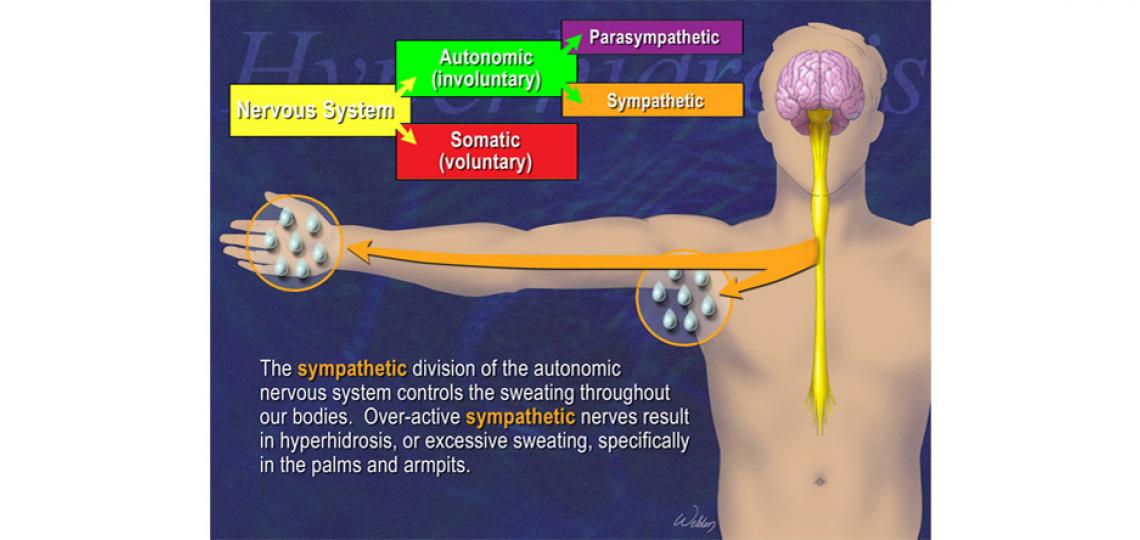At Baylor Medicine, a multidisciplinary team of specialists including dermatologists and surgeons are available to treat excessive sweating involving the palms or underarms, ranging from mild to severe cases.
Excessive Sweating
Excessive perspiration from the palms or underarms can be embarrassing and may cause emotional, professional and social problems. Although bothered by excessive sweating (hyperhidrosis), patients often don't realize it can be treated and therefore do not seek medical help.
The exact cause is unknown; however, 4 out of 10 patients also have relatives with the problem. The reason patients experience symptoms relates to increased activity of certain nerves that are normally triggered under certain stressful situations such as job interviews, special occasions, or test taking.
These patients often experience excessive levels of sweating, even when they are not in stressful situations.
The human body has two different sets of nerves: the voluntary (somatic) nervous system and the involuntary (autonomic) system.
The voluntary nervous system contains nerves that give us sensation (pain, heat and touch) as well as muscle control. The involuntary nervous system contains nerves that control many of our bodily functions that occur without thinking such as breathing, the beating of our heart, and sweating. The involuntary nervous system is made up of two components: the sympathetic and the parasympathetic systems. It is the sympathetic nervous system that controls the sweating throughout our bodies. Some people have overactive sympathetic nerves that cause the sweat glands to produce too much sweat inappropriately so that the person with this condition may be embarrassed by having sweaty hands and armpits during normal daily activities and in certain situations.
Surgical Options
Patients for whom standard non-surgical treatment is not sufficient can be referred to one of our surgical specialists to discuss definitive minimally invasive treatment options such as Endoscopic Thoracic Sympathectomy or ETS.
Endoscopic thoracic sympathectomy requires general anesthesia and typically takes less than one hour to complete. Once the patient is asleep, the surgeon makes two or three small (1/8 inch to 1/4 inch) incisions below the armpit. Through these tiny holes, a miniature video camera is used to locate the sympathetic chain. The surgeon uses special instruments, inserted through the other incisions, to interrupt the chain at a specific level. The same procedure is then performed on the opposite side of the patient's body.
The patient usually remains in the hospital for only a few hours following surgery. Most patients experience mild postoperative discomfort requiring oral pain medication. This usually goes away after 7 to 10 days. The success rate for this type of procedure is above 90 percent with very few severe side effects and a very low failure rate. Most people who undergo this procedure are permanently cured.
The most common side effect is compensatory hyperhidrosis. Compensatory hyperhidrosis occurs when the patient experiences excessive sweating in other areas of the body, such as the chest, back and legs. Although this is a very common side effect, it is usually mild and thus most patients find this condition to be manageable and remain satisfied with the results of the surgery. In rare cases, the compensatory sweating can be severe and create long-term problems and dissatisfaction with the results of the procedure.
Non-Surgical Options
- Topical products Certain Dri and Maxim (OTC) or Drysol (Rx)
- Anticholinergic pills Robinul 1 or 2 mg tablets (two to three times x per day)
- Iontophoresis two to three times per week in the office for ~ 10 treatments
- Botox injection in the office
There are medications such as Drysol®, an astringent, which can be used to dry up the sweat glands. Drysol® is reported to work in 8 out of 10 people who use it to decrease excessive sweating. It is applied at bedtime and then washed off in the morning. Generally, the medicine is repeated nightly until sweating is under control. Thereafter, it can be applied once or twice weekly or as needed.
In addition to Drysol®, many oral medicines have also been prescribed with varying success. These include both sedatives and medications that prevent the sympathetic nerves from stimulating the sweat glands. One of the most recent treatments is an injection of botulinum toxin (Botox®) into the area of excessive sweating. Botulinum is a toxin that affects nerve endings and decreases the transmission of the nerve impulses to the sweat glands. This results in decreased sweating. It generally requires several injections in the palms or underarms and it remains effective from one to six months. Repeated injections are nearly always required to maintain an adequate level of dryness.
Another treatment involves electrically stimulating the sweat glands. Patients place their palms into a water bath through which an electrical current is passed. The mild electric shock tends to "stun" the sweat glands. This treatment has been known to decrease sweating for periods of six hours to one week.








 Credit
Credit
